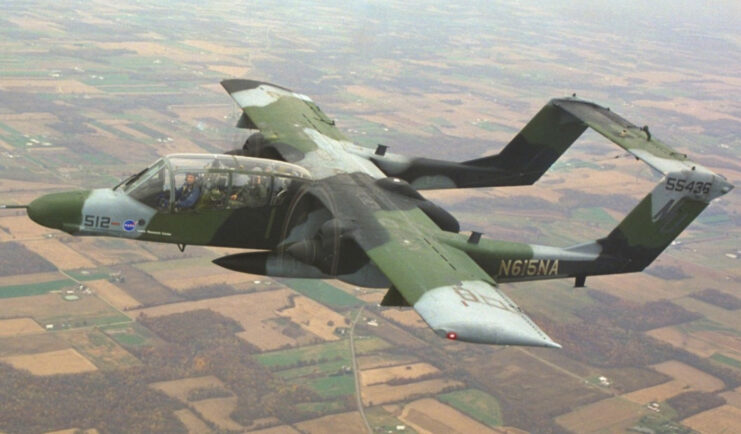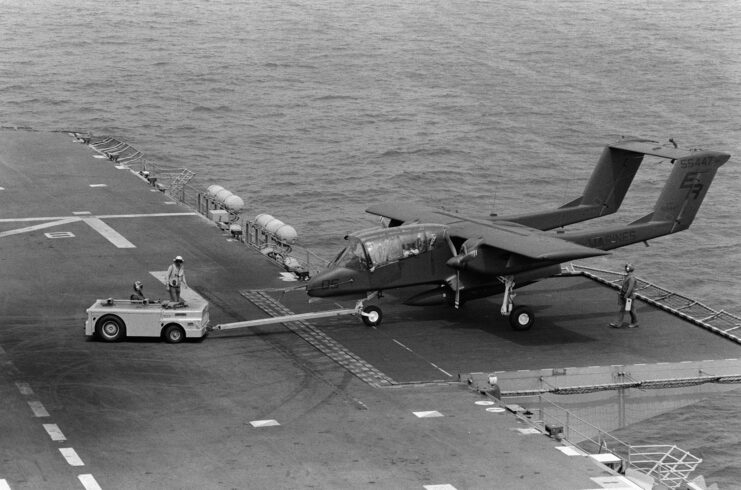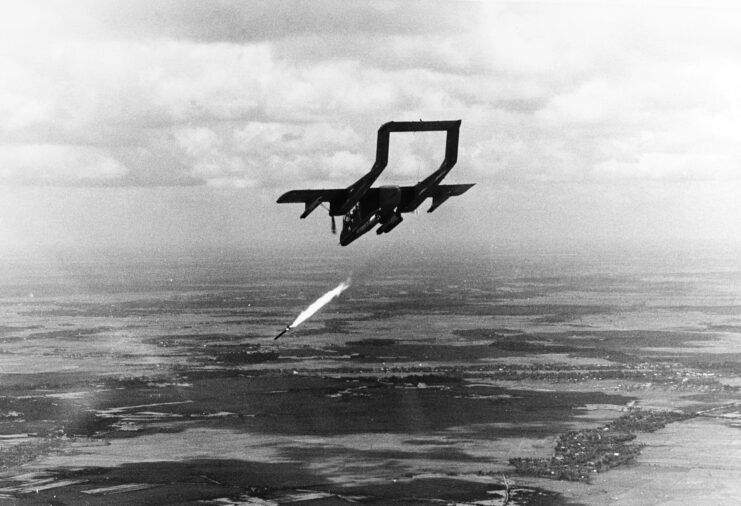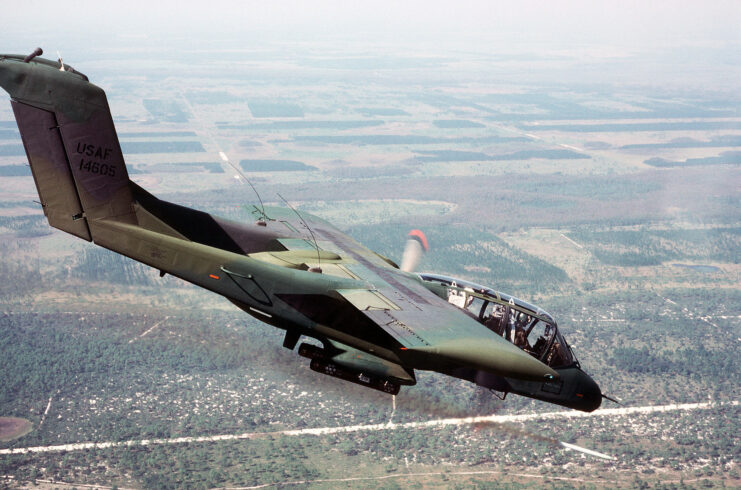The North American Rockwell OV-10 Bronco, renowned for its versatility in light-attack and reconnaissance missions during the Vietnam War, served with the US Air Force, Navy, and Marine Corps.
Although its broader use was initially limited by its power capabilities, its redeployment to the Middle East in 2015 indicates it may still have the potential to make a difference in contemporary military operations.
Development of the OV-10 Bronco

The OV-10 Bronco entered into service with the US military through the “tri-service” program, which required an aircraft suited for “jungle fighting.” The program’s specifications called for an aircraft capable of carrying a variety of weapons, up to 2,400 pounds of cargo, a two-person crew, compatibility with aircraft carrier operations, a twin-engine design, and the ability to operate from very short runways.
Among the eleven submissions was the North American Aviation/Rockwell NA-300, designed by H.K. Beckett and US Marine Corps Col. K.P. Rice. The pair collaborated on the design and presented it to North American Aviation. Once the design was chosen, seven prototypes were commissioned, and the light-attack aircraft—later named the “OV-10 Bronco”—took its first flight in August 1967.
Demonstrating its effectiveness, the OV-10 moved into mass production, with 360 rolling off the manufacturing line between 1965 and 1986.
OV-10 Bronco specs

The OV-10 Bronco had twin booms, connected by a horizontal stabilizer and containing twin Garrett T76-G-420/421 turboprop engines that could, in times of need, be filled by high-octane automobile fuel. These powered three-bladed feathering propellers and allowed the aircraft to travel at a maximum speed of 281 MPH and have a maximum range of 1,240 miles.
In terms of the body, the OV-10 featured cut-off wing tips and a cockpit that afforded the pilot excellent visibility during combat. The underneath portion of the fuselage included “stub wings” – officially known as sponsons – that could be used for storage, while the inside of the cockpit featured ejection seats that ensured aviators could bail out, should the need arise.
As aforementioned, one of the main requirements of the OV-10 was that it could take off within short distances. It was given this capability, as well as the ability to take off from aircraft carriers without the use of catapults or arresting wires.
In terms of armament, the OV-10 was equipped to the brim with guns, rockets and missiles. The “D” variant could feature either four 7.62 mm M60C machine guns or a single 20 mm M197 cannon. Through its seven hard points, it could also carry the AIM-9 Sidewinder, bombs, flares, rockets with white phosphorus, high-explosive rockets and seismic sensors.
Service with the US Air Force

The US Air Force first deployed OV-10 Broncos to Vietnam in July 1968 as part of Operation Combat Bronco, a mission aimed at testing and evaluating the aircraft’s combat capabilities. The OV-10 served in various roles, including as a forward air control (FAC) aircraft and as an escort during Operation Ranch Hand.
Between April and June of 1969, the aircraft underwent further testing in an exercise called “Misty Bronco” within South Vietnam’s III Corps tactical zone. The goal was to demonstrate its effectiveness in light-attack missions, which led to the addition of M60C machine guns.
Two years later, further modifications enhanced the OV-10’s ability to intercept enemy troops and supplies along the Ho Chi Minh Trail.
After the Vietnam War, the OV-10 continued to serve in the Air Force, although its deployments became more limited. It was officially retired in September 1991.
Service with the US Marine Corps

Initially, two observation squadrons were designated to operate it, with each receiving nine OV-10A and nine OV-10D models. To further capitalize on this versatile aircraft, the Marines also established an Air Reserve Observation Squadron. Altogether, the Marine Corps obtained 114 OV-10As, valuing its capability to function from various platforms, such as aircraft carriers and challenging terrains.
Throughout the Vietnam War, the Marines utilized the OV-10 in numerous roles, often exceeding performance expectations. Even after the war, they continued to deploy the aircraft during Operation Desert Storm, despite skepticism from the US Air Force and Navy about its suitability for modern combat.
While the Marines did experience operational losses, they officially retired the OV-10 only in 1995.
Service with the US Navy

The OV-10 Bronco was also used by the US Navy, albeit not to the same extent as the US Air Force and Marine Corps. The formation of Light Attack Squadron Four (VAL-4) by the Navy on January 3, 1969, marked an important moment. VAL-4 was charged with various responsibilities including aerial reconnaissance, offensive operations, fire support, and enemy interdiction in support of Navy SEALs, Marines, and naval river patrol craft.
In April 1969, VAL-4 began combat operations, with its pilots engaging in surveillance and combat missions primarily over the Mekong Delta, particularly notable during the Cambodian Campaign. The squadron’s most important contributions came during this period and the subsequent phases of the Vietnam War, culminating in its final combat sortie in March 1972.
The OV-10 Bronco has seen service with other countries

While in service with the US military during the Vietnam War, the OV-10 Bronco showed the aforementioned issues with being underpowered, which put it at risk in certain combat scenarios, particularly those in sloping terrain. Despite this, several nations adopted it for use by their air forces. West Germany, Colombia, Venezuela, the Philippines, Morocco, Indonesia and Thailand all operated it at one point.
Outside of military purposes, the OV-10 has been operated by the likes of NASA and the US government, with the former using it for research purposes and the latter – in particular, the Department of State – operating the aircraft via DynCorp International for drug interception purposes in South America.
Both the Bureau of Land Management (BLM) and the California Department of Forestry and Fire Protection have also adopted a number for fire prevention and control.
More from us: Bell P-63 Kingcobra: The American Fighter-Turned-Soviet Tank Buster
New! Want to become a trivia master? Sign up for our War History Fact of the Day newsletter!
While widely believed to have been completely retired from military use in the United States, it was reported in 2015 that two OV-10s flew 120 combat missions in the Middle East, presumably in Iraq and Syria, over 82 days.
